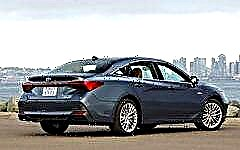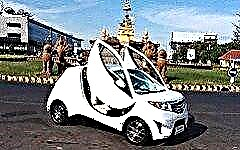

The content of the article:
- Cars of Indochina - top interesting models
Indochina is a peninsula on which Vietnam, Laos, Cambodia, Malaysia, Thailand, partly Bangladesh and Myanmar are located. The list of states is impressive, but the Malaysian industry can boast of a relatively developed state of the automotive industry.
Therefore, a story about the most interesting cars created on the Indochina Peninsula will fit into one article. Perhaps, with the development of production, it will be possible to write a separate material about the cars of each country, but this is a question for the future.
Cars of Indochina - top interesting models
Proton Iriz and Persona (Malaysia)

In the photo: Proton Iriz
The automotive industry in Malaysia has developed relatively recently and solely with the help and support of the government.
In 1983, the country's leadership adopted a program, according to which the phased development of the country's industry and, in particular, the rise of the automotive industry, was envisaged.
As part of the implementation of the adopted program, the automobile company Proton was founded in the country. The founder and owner of the company was the politician and industrialist Mohamad Mahathir.
From 1981 to 2003, Mahathir served as Prime Minister of Malaysia. He has invested a lot of effort and money in the development of domestic engineering, using both his position in parliament and his financial condition.
To the credit of the creator of Proton, it is important to note that this is the only car manufacturer in Malaysia that has managed, albeit with some difficulties, to enter the world market.
The compact five-door Iriz hatchback was unveiled at the 2014 Malaysian Motor Show. Initially, the car was announced exclusively for sale on the domestic market, but over time, manufacturers planned to bring the car to car markets in other countries.
The car in the basic configuration is equipped with a gasoline power unit with direct fuel injection, with a capacity of 1.3 liters and 95 hp, a more powerful version - 1.6 liters, 109 hp. Both options are equipped with a manual or CVT transmission.
In the first year after the debut in the domestic market of Malaysia, more than 200 thousand copies of the car were sold. In 2016, in a pair with Iriz, the company released a longer - 4.4 m - model, the Persona sedan.
Unfortunately, both the hatchback and the sedan did not live up to the manufacturers' expectations: the sales schedule showed a steady drop in demand in both the external and domestic markets.
As a result, it was decided to sell Proton Geely, and currently the holding's specialists are trying to revive the company.
Proton Iriz and Persona have been redesigned. Bumpers of more aggressive lines are now installed on cars, the painting style has changed. A media system appeared, developed by Proton specialists already in conjunction with Geely engineers. This system is equipped with a voice control function and a seven-inch screen. At the same time, the power units of the models remained the same.
At the beginning of 2019, company representatives, announcing the entry into the markets of the updated Iriz and Persona, hinted that they were even ready to go for price dumping in order to increase sales and get the company out of the difficult situation in which it found itself.
The cost of Proton Iriz in the Malaysian markets is about 13 thousand US dollars.
Perouda Axia (Malaysia)

While Malaysian-based Proton has a reputation for being a relatively successful car manufacturer in the international market, it is not the largest car manufacturer in the country.
The laurels of the largest Malaysian automobile company went to Perouda. In our country, this brand is practically unknown, foreign markets can boast only small batches of its cars.
The company was founded in 1992 and began its activity in the field of assembling cars of the Indonesian company Daihatsu, but soon began to produce models of its own design.
The most famous is the five-door hatchback Perouda Axia. The "heart" of the car is a liter engine with a capacity of 67 hp, equipped with a four-speed "automatic" or five-speed "mechanics" - at the buyer's choice.
Starting prices for the model start at $ 7.5K.
Bufori Geneva (Malaysia)

Bufori is a Malaysian company that specializes in sports cars, high-end cars and vintage car replicas. The Bufori Geneva model was created in 2010, but continues to attract interest.
Retro cars are traditionally admired, but there are few hunters to drive them every day: it is not very comfortable to handle a clumsy steering wheel and tight pedals, to do without modern security systems and new gadgets, without which a modern motorist can no longer imagine driving a car.
The Bufori company offered buyers a car with a retro design, but devoid of all of the above drawbacks: this is a modern model with the appearance of a car from the middle of the last century.
Under the hood, the Geneva has a 6.1-liter V8 Chrysler petrol engine with 430 hp.
As befits a retro car, the model amazes with the luxury of the interior: there is even a coffee machine, a refrigerator and a stand for electronic gadgets at the back seat passengers.
The driving process is simplified by a rear-view camera, ABS system, stabilization system and other modules that modern cars are equipped with.
The cost of Bufori Geneva is not so low - 300 thousand US dollars, but for fans of retro cars that are assembled almost by hand, this price is considered quite acceptable.
TD-2000 (Malaysia)

There are other companies in Malaysia that specialize in the production of replicas of cars of the last century. For example, TD CARS, which has existed since 1986. Their main production car is a replica of the famous 1950 MG TD retro convertible, the TD-2000 roadster.
Today TD-2000 is produced in two versions - SilverStone with a five-speed "mechanics" and Gatsby with a four-speed "automatic".
With its steel chassis and independent wishbone front suspension, the TD-2000's handling and ride are far superior to the original. The car is equipped with a two-liter Toyota 3S-FE engine. Experts emphasize the excellent ratio of vehicle weight and power.
TD-2000 found its buyer not only in Malaysia, but also in a number of countries:
- Australia;
- Brunei;
- Great Britain;
- India;
- Ireland;
- Singapore;
- Thailand;
- Philippines.
Mekong Stars-4WD (Vietnam)

Despite a fairly high position in the world economic rankings of other industries, Vietnam cannot boast of a developed automobile production. Meanwhile, this country also has its own cars. One of them is the brainchild of the Mekong plant called Mekong Stars-4WD.
In fairness, it should be noted that this is the only model produced by this assembly plant under its own brand. The plant mainly specializes in the assembly of SsangYong and Fiat vehicles.
Vinaxuki 3450T (Vietnam)

Vinaxuki production was founded in the capital of Vietnam Hanoi in 2004 and is mainly focused on the assembly of Chinese cars. But at the same time, the line of manufactured models also includes its own cars and mini-trucks.
The Vinaxuki 3450T model is quite popular in the domestic Vietnamese automotive market. A truck with a carrying capacity of 3.5 tons perfectly copes with transport tasks both in urban areas and on farms.
VinFast LUX SA 2.0 and LUX A2.0 (Vietnam)

In the photo: VinFast LUX SA
Speaking about cars in Vietnam, the VinFast plant is perhaps worth mentioning. At the Paris Motor Show last year, the manufacturer unveiled its LUX SA 2.0 SUV and LUX A2.0 crossover.
VinFast asserts itself as "the future leading car manufacturer in Vietnam" by enlisting partnerships with venerable automakers such as BMW, Pininfarina, Magna Streyg and Bosch.
Lux SA2.0 is built on the basis of the BMW X5. The car is equipped with an N20-based engine. The model is distinguished by the original BorgWarner all-wheel drive system. The car accelerates to a speed of 100 km / h in 7.1 seconds.
The LUX A2.0 crossover reaches 100 km / h in 8.9 seconds, and is technically called the heir to the BMW 5-Series.
ThaiRung Transformer (Thailand)

This car is the brainchild of Thai brand ThaiRung. The company has been operating since 1967, specializing in the production of vehicles licensed by Toyota, Nissan, Isuzu.
The ThaiRung Transformer looks like the famous American Hummer. Meanwhile, this car is produced on the basis of the Japanese model Toyota Hilux.
As soon as the model in 2011 began to roll off the assembly line, angry journalists dubbed it "another curiosity of the Thai car industry." Indeed, externally, this rear-wheel-drive SUV resembles a bizarre cross between a Hummer-13 and a Land Rover Defender.
A distinctive feature of the car is a roomy body, in the existing seven modifications capable of carrying from 7 to 11 passengers, providing them with places not only in the traditional rear seat, but also on benches that are attached along both sides.
As befits an SUV, the model is equipped with a 2.4-liter Toyota engine with a capacity of 150 hp. paired with an automatic transmission. The circulation of the issue is only a few hundred models per year, and almost all of them are sold exclusively in the domestic Thai market, with the Royal Thai Army being the main buyer of the models.
Judging by the fact that in 2016 the Bangkok Auto Show witnessed the presentation of the updated ThaiRung Transformer II, the creators of the model intend to further develop it.
GolfCar С-FEE Jumbo (Thailand)

Continuing the story about cars in Thailand, it is difficult to ignore the manufacturer C-FEE (in decoding and translation from English - "Clean fuel energy production").
The C-FEE Jumbo is the largest golf cart produced by this company. It has 15 seats.
The company emphasizes that this electric vehicle does not pollute the environment at all and is easy to operate. An eight-module 6V battery with a capacity of 250 Amp-hours ensures long-term use between charges.
Also, the company's manufacturers are deservedly proud of the fact that they produce cars that operate on solar energy. For sunny Indochina, this direction of development is quite justified and, most likely, will develop intensively in the future.
Angkor EV (Cambodia)

Angkor Automobile Plant in Cambodia specializes in the production of compact cars. Back in 2013, the owners of the company presented at the domestic auto show a prototype of their electric car, which, according to them, was supposed to eventually completely displace gasoline cars from the crowded streets of Cambodia.
The small two-door car was designed to address more than just environmental issues. The super-compact design was presented as the most appropriate solution in the conditions of overcrowding and a lack of parking spaces.
Unfortunately, the model presented more than five years ago has remained at the prototype level.
Perhaps these are only the consequences of the international economic crisis, and over time Cambodia will still be able to boast of an electric car of its own production, not only on the podium of a car dealership, but also on city streets.
Conclusion
With all the scarcity of the automotive industry in the countries of Indochina, one should not assume that the state of affairs with the development of automotive production in this region will remain so. These countries are developing intensively and, accordingly, they will definitely try all kinds of methods and directions for creating domestic road transport.
And given that the Indo-Chinese countries have always been distinguished by a bizarre combination of medieval traditions, great diligence and high technology, it is quite possible that their manufacturers will still surprise the rest of the world with their automotive innovations.











